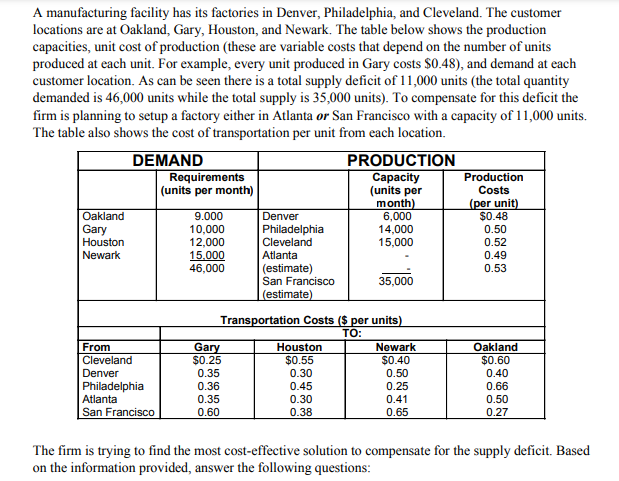1. What are the decision variables for the problem? Are there are any binary (0,1) decision variables? Give some examples of the decision variables you

1. What are the decision variables for the problem? Are there are any binary (0,1) decision variables? Give some examples of the decision variables you have chosen (you need not be exhaustive).
2. You are trying to minimize the total cost. How can you express this objective (the objective function) using your choice of variables?
3. What are the constraints of the problem? That is, what factors must you ensure are satisfied in the optimal solution. Based on the choice of your decision variables express the constraints as inequalities.
4. What is the optimal solution that minimizes the total cost? Use the SOLVER application to find the optimal solution. Interpret the solution (such as where should the new factory be built) in layman terms. Submit the excel sheet with your response.
A manufacturing facility has its factories in Denver, Philadelphia, and Cleveland. The customer locations are at Oakland, Gary, Houston, and Newark. The table below shows the production capacities, unit cost of production (these are variable costs that depend on the number of units produced at each unit. For example, every unit produced in Gary costs $0.48), and demand at each customer location. As can be seen there is a total supply deficit of 11,000 units (the total quantity demanded is 46,000 units while the total supply is 35,000 units). To compensate for this deficit the firm is planning to setup a factory either in Atlanta or San Francisco with a capacity of 11,000 units. The table also shows the cost of transportation per unit from each location. DEMAND PRODUCTION Requirements Capacity (units per month) (units per month) (per unit) Oakland 9.000 Denver 6,000 $0.48 Gary 10,000 Philadelphia 14,000 0.50 Houston 12,000 Cleveland 15,000 0.52 Newark 15.000 Atlanta 0.49 46,000 (estimate) 0.53 San Francisco (estimate) Production Costs 35,000 From Cleveland Denver Philadelphia Atlanta San Francisco Transportation Costs ($ per units) TO: Gary Houston Newark $0.25 $0.55 $0.40 0.35 0.30 0.50 0.36 0.45 0.25 0.35 0.30 0.41 0.60 0.38 0.65 Oakland $0.60 0.40 0.66 0.50 0.27 The firm is trying to find the most cost-effective solution to compensate for the supply deficit. Based on the information provided, answer the following questions: A manufacturing facility has its factories in Denver, Philadelphia, and Cleveland. The customer locations are at Oakland, Gary, Houston, and Newark. The table below shows the production capacities, unit cost of production (these are variable costs that depend on the number of units produced at each unit. For example, every unit produced in Gary costs $0.48), and demand at each customer location. As can be seen there is a total supply deficit of 11,000 units (the total quantity demanded is 46,000 units while the total supply is 35,000 units). To compensate for this deficit the firm is planning to setup a factory either in Atlanta or San Francisco with a capacity of 11,000 units. The table also shows the cost of transportation per unit from each location. DEMAND PRODUCTION Requirements Capacity (units per month) (units per month) (per unit) Oakland 9.000 Denver 6,000 $0.48 Gary 10,000 Philadelphia 14,000 0.50 Houston 12,000 Cleveland 15,000 0.52 Newark 15.000 Atlanta 0.49 46,000 (estimate) 0.53 San Francisco (estimate) Production Costs 35,000 From Cleveland Denver Philadelphia Atlanta San Francisco Transportation Costs ($ per units) TO: Gary Houston Newark $0.25 $0.55 $0.40 0.35 0.30 0.50 0.36 0.45 0.25 0.35 0.30 0.41 0.60 0.38 0.65 Oakland $0.60 0.40 0.66 0.50 0.27 The firm is trying to find the most cost-effective solution to compensate for the supply deficit. Based on the information provided, answer the following questionsStep by Step Solution
There are 3 Steps involved in it
Step: 1

See step-by-step solutions with expert insights and AI powered tools for academic success
Step: 2

Step: 3

Ace Your Homework with AI
Get the answers you need in no time with our AI-driven, step-by-step assistance
Get Started


